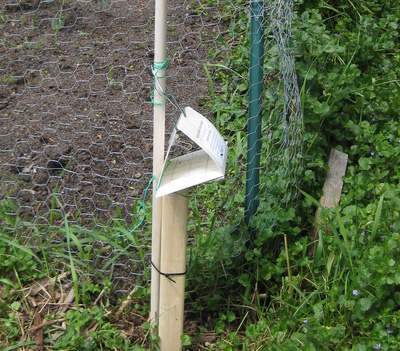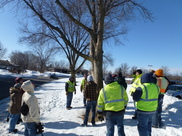|
The Swede midge (Contarinia nasturtii) is a tiny fly (~2 millimeters long) that infests cruciferous crops such as broccoli, cabbage and canola. Swede midge was first discovered in North America in 2000 and is now known to occur in a number of states and provinces in eastern North America. The MDA has monitored for Swede midge for the past few years with support from USDA APHIS in community gardens and small farms in and near urban areas where the risk of pest introduction is greatest. During 2016, the MDA captured specimens suspected to be Swede midge in both Ramsey and Hennepin Counties and the identifications were recently confirmed by the USDA.
These finds are of concern for growers of susceptible crops but it may be some time before damage from this pest is evident. Swede midge was only found at two sites out of 90+ that were monitored statewide. The MDA will be working with the University of Minnesota and other partners to continue monitoring for this pest during 2017 as well as tailoring current management options for Minnesota growers.
Read more about the Swede midge at the MDA website.
 Swede midge trap near garden plot
 Minnesota Department of Agriculture staff will be leading FREE emerald ash borer (EAB) field workshops soon:
- Rochester, February 21-24
- St Paul, February 27 - March 3
- Superior, WI, March 7 - 9
The hour-long workshops will begin each day at 9:00 AM, 10:30 AM and 1:30 PM. They will provide a firsthand look at EAB-infested trees and build EAB early detection skills. General EAB biology, distribution, management and regulations will also be covered. Workshops are provided free of charge with support from the U.S. Forest Service.
You can register online, by emailing Jennifer.Burington@state.mn.us, or calling 651-201-6097. Maps and instructions will be provided with registration confirmation.
|
 The Minnesota Department of
Agriculture (MDA), in collaboration with federal, state, and local partners, is
proposing to slow the spread of gypsy moth populations during spring of 2017. Surveys in 2016 revealed three distinct
areas where monitoring traps caught a high numbers of moths. Treatment blocks have
been identified and named for their geographic locations: Richfield in Hennepin
County, Hinckley in Pine County, and Pine Creek in Winona County.
The MDA proposes to treat a total of about 1,120 acres of land
with Bacillus thuringiensis var. kurstaki, or
Btk, and about 1,751 acres with a pheromone that inhibits males moths from finding females and disrupts mating.
MDA is hosting three public open
houses to share information related to these proposed treatment projects:
- March 1, 4:00-6:30 PM, Sheridan Hills Elementary, 6400 Sheridan Avenue S, Minneapolis, MN 55423
- March 2, 6:00-7:00 PM, New Hartford Town Hall, 42774 County Road 12, Nodine, MN 55925
- March 7, 6:00-7:00 PM, Hinckley Community Room, 106 First Street SE, Hinckley, MN 55037
For more information
visit: www.mda.state.mn.us/gmtreatments
|
The MDA will soon be looking for help with the upcoming gypsy moth survey season. Every year the MDA monitors thousands of gypsy moth pheromone traps to inform management efforts as part of a national program to slow the spread of this forest defoliator across the U.S.
These jobs are a great opportunity to work outdoors, travel to new areas, encounter wildlife and work independently.
Keep tabs on the State of Minnesota Careers website for the job posting. A single post will advertise all of the trapping positions available. The map below highlights areas of the state where help will be needed.
Areas where gypsy moth trappers are needed is shaded in green.
 New this year the First
Detector Program will be incorporating a flipped classroom approach for
our face-to-face workshops with significant
technical and species specific content provided before the workshop
through the
University of Minnesota's online learning platform, Moodle. This will
allow
workshop participants more hands-on time with pest displays, time to
talk and
brainstorm with content specialists and more peer-to-peer learning
during
the workshop. In addition, the digital content, available in Moodle,
will be
accessible to all Forest Pest First Detectors (including those that
completed
the program since 2008) after the workshops. So you can revisit and
share this
great content more easily.
As always, anyone interested in forests and trees including
foresters, arborists and master volunteers (who are comfortable with tree
identification) are welcome to attend a FPFD workshop and hopefully become FPFD
volunteers.
For additional information on the Forest Pest First Detector
program and to report forest pests visit our website.
Two Forest Pest First Detector Workshops will be held this spring:
- Thursday, March 2, 2017, 8:00 AM - 3:00 PM. Cloquet Forestry Center, 175 University Road, Cloquet, MN 55720
- Wednesday, March 8, 2017, 8:30 AM - 3:30 PM. Oakdale Discovery Center, 4444 Hadley Ave N, St Paul, MN 55128
Workshop registration is $50 and payable online. Registration is through the University of Minnesota.
|
 Tetrastichus planipennisi, a parasitoid of the emeral ash borer
Emerald ash borer parasitoids
are tiny, stingless wasps which lay eggs in or on life-stages of EAB,
consuming the EAB life-stage as they develop. The MDA has worked with
USDA APHIS and other partners to establish these natural enemies of EAB
in Minnesota.
A primary goal
has been to find better ways to monitor for the wasps to help
understand what impact they are having on EAB populations. This summer
the MDA worked at Fort Snelling State Park, which is a site where the
parasitic wasps have been released in the past, to monitor for the wasps
using yellow pan traps. These traps are simply shallow yellow bowls filled with clear propylene glycol (low toxicity antifreeze). The color
is attractive to the wasps which become trapped in the fluid.
This monitoring method worked quite well as several wasps from one of the released species (Tetrastichus planipennisi) were recovered. The trapping provides a more efficient way to determine if T. planipennisi is active at sites where it was released in previous years. The alternative is debarking trees to search for parasitized EAB larvae which is very labor intensive.
Work to introduce and monitor populations of EAB parasitoids has been supported by the Environment and Natural Resources Trust Fund. For more information on this work, visit the MDA website.
 |
|
The 55th Annual Minnesota Shade Tree Short Course will be held March 14-15, 2017 at Bethel University, Arden Hills.
Registration is open at the Short Course website.
|
 The February Weed Topic of the Month is the "Cut Flower Pathway". Read more about this topic at the MDA website.
|
|